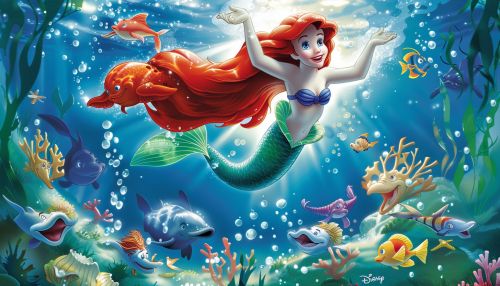The Little Mermaid (1989 film)
The Little Mermaid (1989 film)


Introduction
The Little Mermaid is a 1989 animated musical fantasy film produced by Walt Disney Feature Animation and released by Walt Disney Pictures. It is based on the Danish fairy tale of the same name by Hans Christian Andersen. The film was directed by Ron Clements and John Musker, with music by Alan Menken and lyrics by Howard Ashman. It marked the beginning of the Disney Renaissance, a period of successful animated films that revitalized the Disney brand.
Plot
The narrative follows Ariel, a young mermaid princess who dreams of becoming human. She falls in love with Prince Eric, a human prince, and makes a dangerous deal with Ursula, a sea witch, to become human for three days. In exchange, Ariel must give up her voice. The plot unfolds as Ariel navigates the challenges of her new life on land and the complications of her deal with Ursula.
Characters
- Ariel: The protagonist, a 16-year-old mermaid princess with a passion for human culture.
- Prince Eric: A human prince who becomes Ariel's love interest.
- Ursula: The antagonist, a sea witch who tricks Ariel into giving up her voice.
- Sebastian: A red Jamaican crab and King Triton's advisor, who is tasked with keeping an eye on Ariel.
- Flounder: Ariel's best friend, a tropical fish who accompanies her on her adventures.
- King Triton: Ariel's father and the ruler of Atlantica, the underwater kingdom.
- Scuttle: A seagull who provides comic relief and misinformation about the human world.
Production
The production of The Little Mermaid began in the mid-1980s. Ron Clements and John Musker pitched the idea to Disney executives, who were initially hesitant due to the perceived failure of previous mermaid-themed projects. However, the success of The Great Mouse Detective (1986) convinced the studio to greenlight the project.
Animation
The animation process involved a combination of traditional hand-drawn techniques and innovative methods. The film utilized the CAPS (Computer Animation Production System) technology, which was developed by Pixar and allowed for more efficient and detailed animation. The underwater scenes required special attention to fluid dynamics and lighting to create a believable aquatic environment.
Music
Alan Menken and Howard Ashman were brought on board to compose the film's music. The soundtrack includes iconic songs such as "Part of Your World," "Under the Sea," and "Kiss the Girl." The music played a crucial role in the film's success, earning two Academy Awards for Best Original Score and Best Original Song ("Under the Sea").
Themes
The Little Mermaid explores themes of identity, sacrifice, and the pursuit of dreams. Ariel's journey reflects a universal desire for self-discovery and the lengths one will go to achieve their aspirations. The film also addresses the consequences of making deals with malevolent forces and the importance of family and loyalty.
Reception
Upon its release, The Little Mermaid received widespread acclaim from critics and audiences alike. It was praised for its animation, music, and storytelling. The film grossed over $211 million worldwide and won numerous awards, including two Academy Awards and two Golden Globe Awards.
Legacy
The Little Mermaid is credited with revitalizing the Disney brand and ushering in the Disney Renaissance. It has inspired various adaptations, including a Broadway musical, television series, and live-action remake. The film's success paved the way for subsequent Disney classics such as Beauty and the Beast (1991), Aladdin (1992), and The Lion King (1994).
